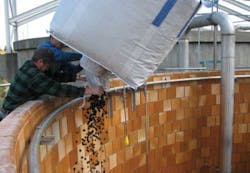Off-Site Regeneration of Condensate Polishing Resins
Today's power plants are more frequently choosing off-site regeneration for the ion exchange resins used in boiler feedwater makeup applications. These plants have shown an interest in doing the same with their condensate polishing resins. Benefits include reducing acid and caustic usage and storage onsite, reducing wastewater, and reducing the capital investment required in upgrading the aging fleet of condensate polishers. For new power plants, off-site regeneration can significantly reduce capital and installation costs as well as building size.
Condensate polishing plants (CPP) are primarily an ion exchange system designed to remove ionized contaminants, but they also act as a filter, removing corrosion products referred to as crud. Both ionized contaminants and crud can enter the system through a variety of sources during normal operation or start-ups/restarts. Removing the contaminants allows the plant to start up faster; operate with minor condenser leaks; reduce frequency of routine cleanings; increase on-line time; and maintain desired system chemistry. By reducing corrosion and deposits in the system, the operating costs will be less and the plant's life extended.
Once the CPP's ion removal capacity has been "exhausted" such that it can no longer produce the desired quality, the resin must be regenerated. The CPP may also need to be removed from service if the pressure loss across the polisher has reached the specified level, due to crud loading on the resin. In either case, the resin is removed from the polisher vessel and transferred to an external regeneration system for regeneration or physical cleaning. Traditionally, the external regen system has been an integral part of the CPP, located at the power plant site. Recently, more plants are having resins regenerated off-site.
Off-Site Regeneration
Off-site regeneration can be considered when designing new plants and also used for existing plants. Many existing CPPs were designed and installed in the 1960-70s, and have provided years of reliable service; however, they have reached the end of their life and have become unreliable, placing a heavy demand on operators, and, in some cases, posing a safety risk. In most cases they may be unable to produce the quality required and are incompatible with new system chemistries.
Replacing old CPPs with a new one with off-site regeneration makes sense for several reasons:
- Finding space within an existing plant to locate a new CPP is extremely difficult
- Installing a new plant or modifying an existing one during normal operation or an outage is challenging
The economic drivers for using off-site regeneration are:
- Reducing operator involvement, allowing them to focus elsewhere
- Reducing type and quantity of chemicals stored on-site
- Eliminating wastewater treatment and discharge of the CPP
- Eliminating the need for periodic enhanced chemical cleaning of the resin to restore performance
- Eliminating uncertainty in predicting resin life and replacement
- Reducing the size of the building for new facilities
- Reducing capital investment
Design Considerations
The minimum requirement for a new off-site regenerated CPP would be adding a mixed-bed polisher (MBP). The plant could be designed for continuous full flow operation or partial flow operation, processing a portion of the condensate flow and/or bypassing a portion of the full flow at various times during operation.
The MBP should have internals that ensure uniform flow distribution and collection. The inlet distributor should prevent resin movement, and should maintain a uniform bed depth to maximize resin capacity and minimize resin attrition. The internals should be designed to facilitate complete removal (99.9%) of the exhausted resin. The MBP should also include provisions for remixing the resin bed in case the cation and anion resin become separated during the movement of the resin. This feature can also be used to level the bed after a fresh charge of resin has been sluiced into the MBP.
Another consideration is the need for a fresh resin storage tank and a spent resin storage tank. The value of having these tanks will depend heavily on the proximity to the service center used for off-site regeneration and that provider's ability to respond to a call for fresh resin. These vessels should have resin removal efficiencies similar to the MBP to ensure uniform resin management within the system. The vessels should be positioned to facilitate resin movement to and from the resin transfer trucks by the plant's operators or the service provider's technicians.
On-Site to Off-Site Conversion
Converting an existing on-site plant to off-site regeneration is more complex than designing an off-site regeneration system for a new power plant. If possible, existing MBPs or the vessels in the external regeneration system should be re-used, as this will save on capital costs. The MBP could be reused if it is in good physical condition and is designed to effectively sluice resins.
The inability to re-mix in the existing MBP is a major issue. As the underdrains in the older MBPs were sized to accommodate the condensate flow only for collection at high hydraulic loadings, they have a very large open area to minimize pressure loss. Thus, when the same underdrain is required to act as an air distributor, there is not enough backpressure to provide the needed air distribution.
Also, many older MBPs were not designed to handle the corrosive nature of the MBP effluent, due to the absence of conditioning chemicals such as ammonia and ETA that minimize the corrosion of the carbon steel in the condensate polisher.
The logistics of the MBP's location in relation to the delivery/receiving trucks should also be considered to ensure proper removal and loading of ion exchange resins.
The number of MBPs required will vary depending on condensate flow rate and desire to maximize on-site fresh resin capacity. The best design would be one that minimizes the number of MBPs, since it offers the lowest capital cost and minimizes the number of MBP regenerations. This would typically mean either two, 100% capacity MBPs or three, 50% MBPs. In addition, the fresh resin storage tank should contain a fully regenerated resin charge. Thus, the on-site resin capacity would be equivalent to either three or four full resin charges.
The only value of the existing on-site external regeneration system would be to reuse some of the regeneration vessels as fresh or exhausted resin storage vessels. These would be subject to the same concerns mentioned with respect to reusing the MBP.
New Plant Implementation
Designing an off-site regenerated CPP would be much simpler to implement at a new power plant. The plant could be designed to facilitate the movement and storage of the resin. If the service provider's off-site external regeneration plant is nearby, it might be possible to completely eliminate both the fresh-resin and exhausted-resin tanks. The fresh resin could be sluiced from the delivery truck to the MBP, and the exhausted resin could be transferred directly from the exhausted MBP to the resin truck. If, however, the plant wanted the ability to immediately re-charge a MBP, then it would need on-site fresh- and exhausted-resin storage. The exhausted resin tank could be sized for a single or multiple bed capacity. For the fresh resin tank, multiple tanks with each tank having a single MBP resin charge, or a multi-compartmented fresh resin storage tank, would be required. Delivery trucks with multiple compartments would also be required in order to be cost effective.
Resin Selection and System Chemistry
Off-site regeneration expands the ion exchange resin selection. The ratio of cation to anion resin can be changed with virtually no impact on the CPP when off-site resin regeneration is used. Many on-site regeneration systems can limit, if not prevent, a change in the resin ratio once the plant has been designed and built. The types of ion exchange resins can vary depending on the type of power plant and its system chemistry. With off-site regeneration of the polisher resin, the plant may operate in the H/OH cycle or the ammonia cycle to suit the plant's system chemistry.
Minimum Requirements
Off-site regeneration systems should be able to perform all the functions of an on-site regeneration system. It would be helpful if the off-site regeneration system performed additional resin conditioning services to enhance CPP performance. Ideally, cross contamination of resins should be minimal after separation. The resin separation techniques may vary depending on the capabilities of the vendor providing the service. In general, there are three choices: hydraulic/density separation, chemical separation, and mechanical screening. The technique chosen depends on which one will allow the service provider to guarantee CPP performance.
The off-site regeneration system should have provisions for mechanically cleaning the resin both before and after chemical regeneration. The system should use sulfuric acid, rather than hydrochloric acid, to regenerate cation resin. The anion resin should use heated caustic and demineralized water for caustic dilution. It is critical that the final stored regenerated resin volume be equal to that of a MBP charge so that resin inventory stays in balance.
The final re-mix and rinse must be conducted for the MBP resin charge at the off-site regeneration facility to make sure there is no problem once the resin is returned to the MBP.
Regeneration Services
The CPP performance is controlled by the MBP hydraulic/mechanical design and the ability to effectively regenerate/condition the resin. The responsibility of these two factors should not be separated. This is critical for off-site regeneration with a new CPP or retrofit of an existing CPP with new MBP. The performance acceptance test should be conducted with responsibility for design and resin regeneration with a single organization.
It is virtually impossible for the acceptance test to be conducted unless a service provider will regenerate/condition the resin during start-up and commissioning. Ideally, the power company should be involved in selecting this service provider.
Some questions to ask the service provider:
- Is there laboratory support to analyze effectiveness of the regeneration/conditioning?
- How do you measure for cross contamination and resin conversion?
- Do you have an adequate fleet of resin transportation trucks? Are they multi-compartmented, and are they equipped with air transfer systems?
References: Guideline for Off-site Regeneration of Condensate Polishing Resins, EPRI, Palo Alto, Calif.: 2001.1001502.
About the Author: Gerald Alexander is Global Director for Process Water, Integrated Solutions, at Siemens Water Technologies. He can be reached at [email protected]. For more information, please visit: www.water.siemens.com/en/applications/industrial_process_water/condensate_polishing/Pages/default.aspx
Past IWW Issues


